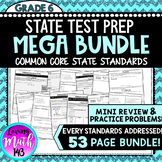State Test Prep: The Number System (BUNDLE)
- Zip
- Easel Activity
Products in this Bundle (7)
showing 1-5 of 7 products
Bonus
Also included in
- Everything you need to know for the 6th Grade Common Core State TestThis sixth grade math test preparation bundle is designed to review and prepare students for the State Tests. Students will review all the standards for math. This BUNDLE includes everything you need to know for the 6th Grade CommonPrice $45.00Original Price $56.00Save $11.00
Description
State Test Prep: The Number System (BUNDLE)
This Bundle included 14 pages of review designed to review for the 6th Grade Common Core State Test. The focus on this review is The Number System which asks students to:
★ Multiply and divide fractions.
★ Find common factors and multiples. (LCM / GCF)
★ Least Common Multiple & Greatest Common Factor
★ Add, Subtract, Multiply and divide decimals.
★ Use positive and negative numbers to describe quantities. (Integers)
★ Plot Fractions, Decimals, and rational numbers on a number line.
★ Understand ordering and absolute value of rational numbers.
★ The Coordinate Plane, Reflection, and Distance.
This product includes:
6.NS.A.1, 6.NS.B.3, 6.NS.B.4, 6.NS.C.5, 6.NS.C.6A, 6.NS.C.6B, 6.NS.C.6C, 6.NS.C.7A, 6.NS.C.7B, 6.NS.C.7C, 6.NS.C.8
***********************************************************************************************
HOW TO USE:
NO PREP NECESSARY! Simply make copies for your students and review! Answer key is included!
***********************************************************************************************
WHATS INCLUDED:
★ Multiply and divide fractions.
★ Find common factors and multiples. (LCM / GCF)
★ Add, Subtract, Multiply and divide decimals.
★ Plot Fractions and Decimals on a number line.
★ Understand ordering and absolute value of rational numbers.
OTHER ITEMS YOU MAY ALSO LIKE:
• GCF and LCM Matching Activity
• LCM & GCF Math interactive Notes Foldable
• LCM and GCF Bundle: Notes, Matching Activity & more!
• Least Common Multiple (LCM) vs. Greatest Common Factor (GCF) Anchor Chart
• Least Common Multiple: Color By Number Math Activity
• Dividing Fractions and Mixed Numbers Anchor Chart Poster
• Fraction, Decimal, Percent Equivalencies / Conversions
• Multiplying & Dividing Fractions Foldable Notes
• Multiplying Fractions Anchor Chart
• Adding Decimals Anchor Chart
• Adding and Subtracting Decimals Task Cards
• Decimal Operations Math Interactive Notes Foldable
• Multiplying Decimals Anchor Chart
• Reading Decimals Anchor Chart
• State Test Prep: The Number System - Decimal Operations
• Math Maze: The Distributive Property (Distributing IN & Factoring OUT)
• Valentine's Day: The Distributive Property - Solve & Color
• Positive and Negative Integers Coloring Activity (Perfect for Valentine's Day!)
• Sea Level Anchor Chart Positive / Negative Integers
• Absolute Value Anchor Chart Poster
• GCF and LCM Matching Activity
• LCM & GCF Math interactive Notes Foldable
• LCM and GCF Bundle: Notes, Matching Activity & more!
• Least Common Multiple (LCM) vs. Greatest Common Factor (GCF) Anchor Chart
• State Test Prep: The Number System - Decimal Operations
• State Test Prep: The Number System - Multiplying & Dividing Fractions
• State Test Prep: The Number System Review (Grade 6)
***********************************************************************************************
LICENSING TERMS: This purchase includes a license for one teacher only for personal use in their classroom. Licenses are non-transferable, meaning they can not be passed from one teacher to another. No part of this resource is to be shared with colleagues or used by an entire grade level, school, or district without purchasing the proper number of licenses.
COPYRIGHT TERMS: This resource may not be uploaded to the internet in any form, including classroom/personal websites or network drives, unless the site is password protected and can only be accessed by students.





